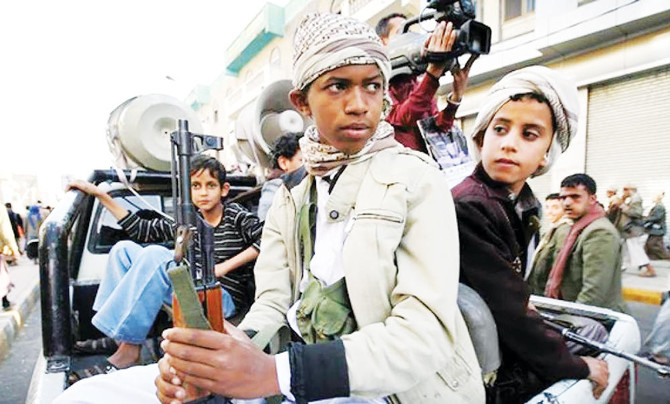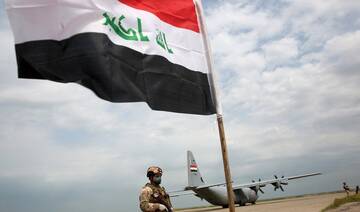ADEN: UN aid chief Stephen O’Brien was “denied passage” on Tuesday to Yemen’s third largest city Taiz where government loyalists are besieged by Iran-backed Houthi rebels, a UN statement said.
“O’Brien’s convoy was denied passage at the final checkpoint before crossing the frontline” into Taiz, said a statement by the UN’s Office for the Coordination of Humanitarian Affairs (OCHA).
He was denied access to the flashpoint city “despite having received assurance of safe passage by all parties,” the statement said.
OCHA did not name the party that prevented O’Brien’s convoy from proceeding. But the route from the north to Taiz is controlled by the rebels and their allies.
“After being denied access, the convoy returned to the safe ground to continue negotiating access with the authorities controlling the final checkpoint, but to no avail,” OCHA said.
“O’Brien was extremely disappointed that humanitarian efforts to reach people in need were once again thwarted by parties to a conflict, especially at a time when millions of Yemenis are severely food insecure and face the risk of famine,” it added.
A local official told AFP earlier that O’Brien was stopped at a rebel checkpoint in Hizran, 15 km northwest of Taiz, while the government-run news agency Saba accused Houthis of opening fire at his convoy.
In a statement to Saba, the government said the rebels blocked O’Brien’s access to Taiz to “prevent the truth about the situation in the city, including a suffocating siege... from reaching the world.”
Meanwhile, the UN said nearly 1,500 children have been recruited in the Yemen war mostly by the Houthis, since March 2015.
The UN has verified the recruitment of 1,476 children, all boys, between March 26, 2015 and Jan. 31, 2017, said a statement by the spokesperson for the UN High Commissioner for Human Rights (UNHCR), Ravina Shamdasani.
“The numbers are likely to be much higher as most families are not willing to talk about the recruitment of their children, for fear of reprisals,” she said.
“Just last week, we received new reports of children who were recruited without the knowledge of their families,” she said, adding that children under 18 are either being “misled or attracted by promises of financial rewards or social status.”
“We remind all parties to the conflict that the recruitment and use of children in armed conflict is strictly forbidden by international human rights law and international humanitarian law,” said Shamdasani.
The recruitment of children under 15 “may amount to a war crime,” she added. “We urge them to immediately release such children.”
Separately, rights group Amnesty International accused the Houthis of “actively recruiting boys as young as 15.” It cited witnesses speaking of financial incentives to families, including monthly salaries ranging between $80 and $120 for every family of a child “martyr.”
“It is appalling that Houthi forces are taking children away from their parents and their homes, stripping them of their childhood to put them in the line of fire where they could die,” said Samah Hadid, deputy director at Amnesty’s Beirut regional office.
Amnesty documented the cases of four boys taken in mid-February, saying that their families later received news that their sons were at an unnamed location on the border.
The International Committee of the Red Cross said Yemen has food reserves for only two to four months, bringing it to the brink of famine.
Houthis block UN aid chief’s passage
Houthis block UN aid chief’s passage

UN chief visits Iraq to mark end of assistance mission set up after 2003 invasion

- Sudani said his country “highly values” the mission’s work in a region “that has suffered for decades from dictatorship, wars, and terrorism”
- Guterres praised “the courage, fortitude and determination of the Iraqi people”
BAGHDAD: United National Secretary-General Antonio Guterres was in Baghdad on Saturday to mark the end of the political mission set up in 2003 following the US-led invasion of Iraq that toppled Saddam Hussein.
The UN Security Council, at Iraq’s request, voted last year to wind down the mandate of the United Nations Assistance Mission in Iraq (UNAMI), by the end of 2025. The mission was set up to coordinate post-conflict humanitarian and reconstruction efforts and help restore a representative government in the country.
Iraqi caretaker Prime Minister Mohammed Shia Al-Sudani said his country “highly values” the mission’s work in a region “that has suffered for decades from dictatorship, wars, and terrorism.” He said its conclusion showed Iraq had reached a stage of “full self-reliance.”
“Iraq emerged victorious thanks to the sacrifices and courage of its people,” he said in a joint statement with Guterres.
The ending of UNAMI’s mandate “does not signify the end of the partnership between Iraq and the UN,” Sudani said, adding that it represents the beginning of a new chapter of cooperation focused on development and inclusive economic growth.
The prime minister said a street in Baghdad would be named “United Nations Street” in honor of the UN’s work and in recognition of 22 UN staff who were killed in an Aug. 19, 2003, truck bomb attack on the Canal Hotel in Baghdad, which housed the UN headquarters.
Guterres praised “the courage, fortitude and determination of the Iraqi people” and the country’s efforts to restore security and order after years of sectarian violence and the rise of extremist groups, including the Daesh group, in the years after the 2003 invasion.
“Iraqis have worked to overcome decades of violence, oppression, war, terrorism, sectarianism and foreign interference,” the secretary-general said. “And today’s Iraq is unrecognizable from those times.”
Iraq “is now a normal country, and relations between the UN and Iraq will become normal relations with the end of UNAMI,” Guterres added. He also expressed appreciation for Iraq’s commitment to returning its citizens from the Al-Hol camp, a sprawling tent camp in northeastern Syria housing thousands of people — mostly women and children — with alleged ties to the IS.
Guterres recently recommended former Iraqi President Barham Salih to become the next head of the UN refugee agency, the first nomination from the Middle East in half a century.
Salih’s presidential term, from 2018 to 2022, came in the immediate aftermath of the Daesh group’s rampage across Iraq and the battle to take back the territory seized by the extremist group, including the key northern city of Mosul.
At least 2.2 million Iraqis were displaced as they fled the IS offensive. Many, particularly members of the Yazidi minority from the northern Sinjar district, remain in displacement camps today.











